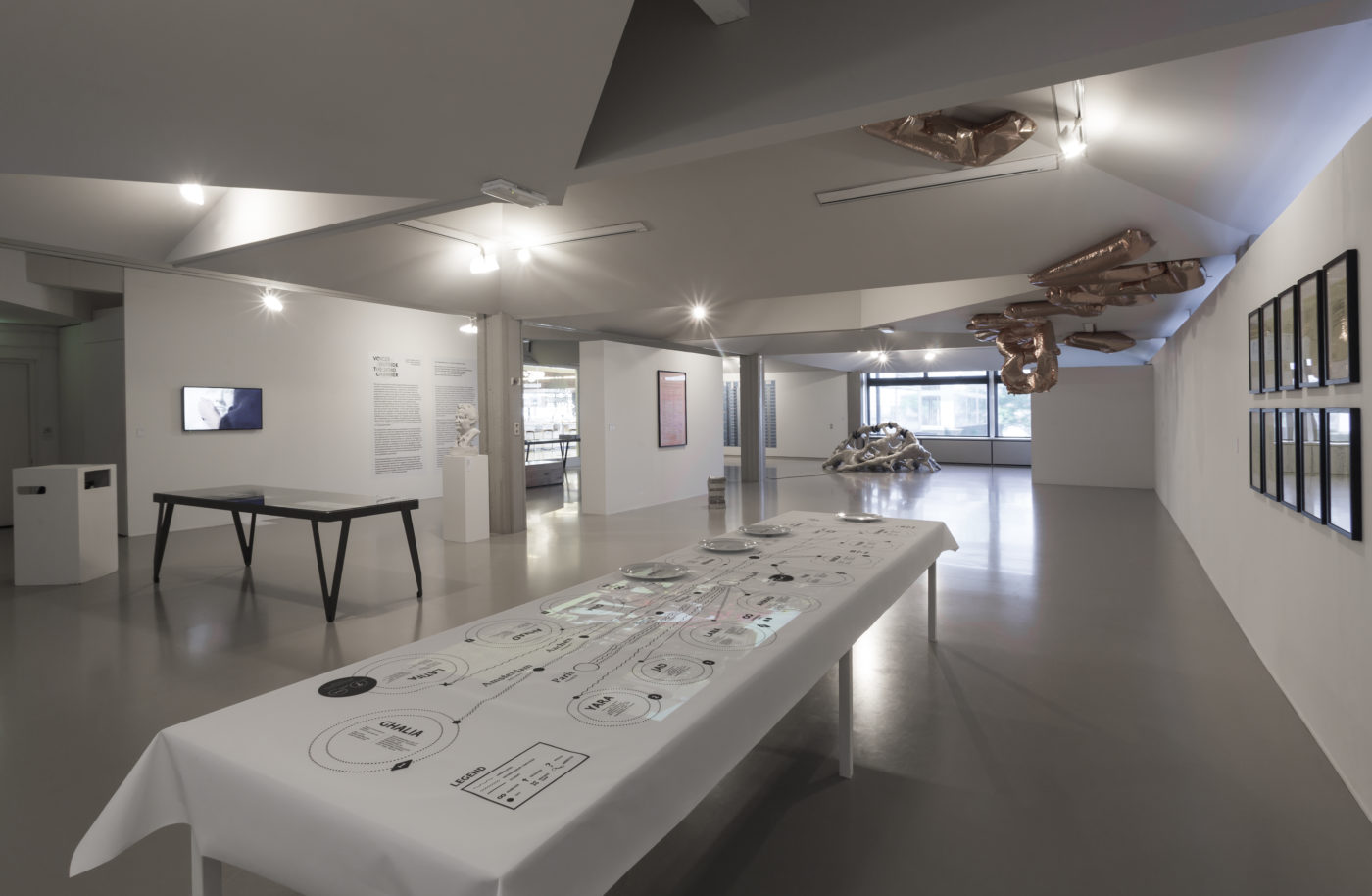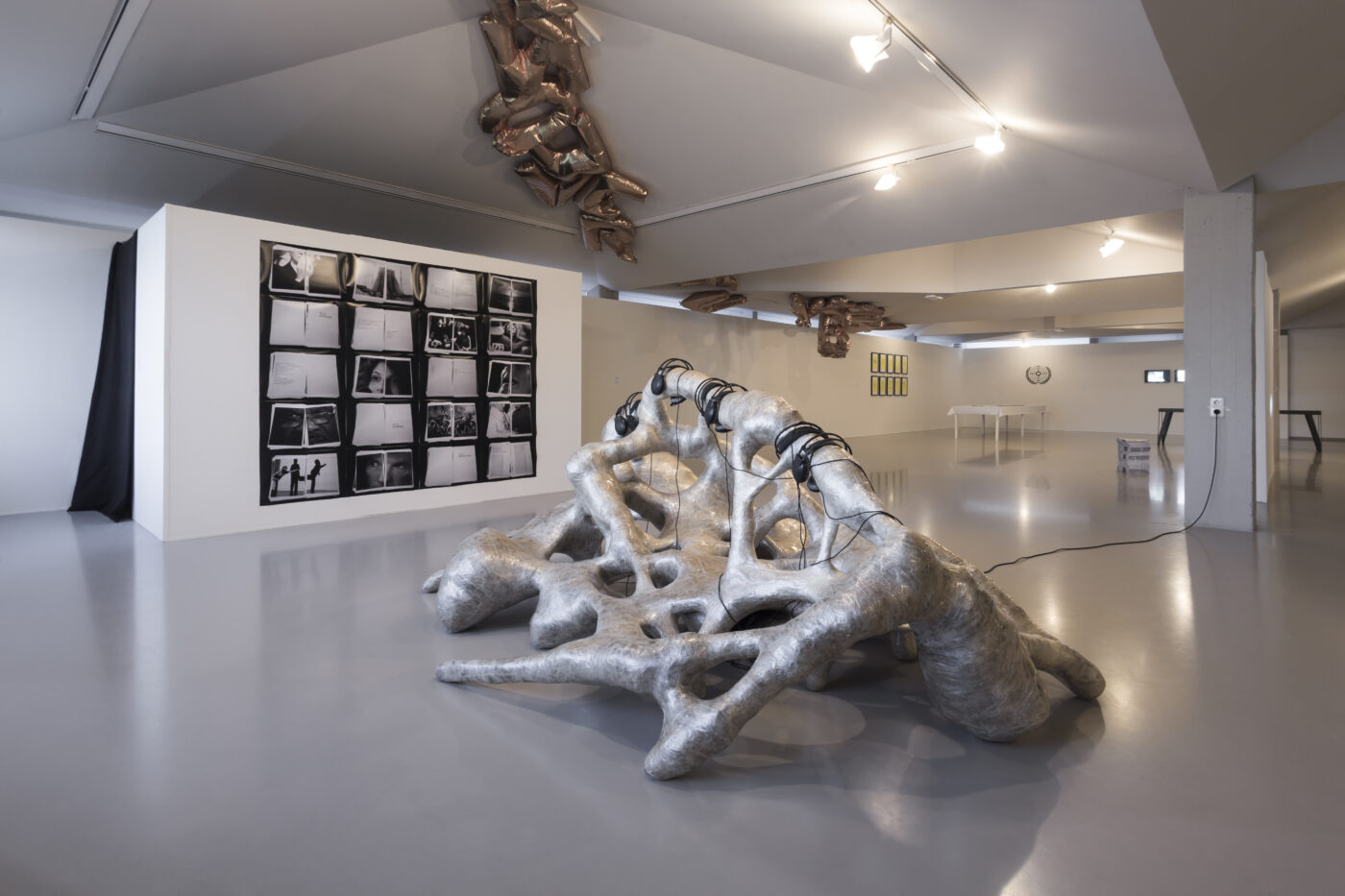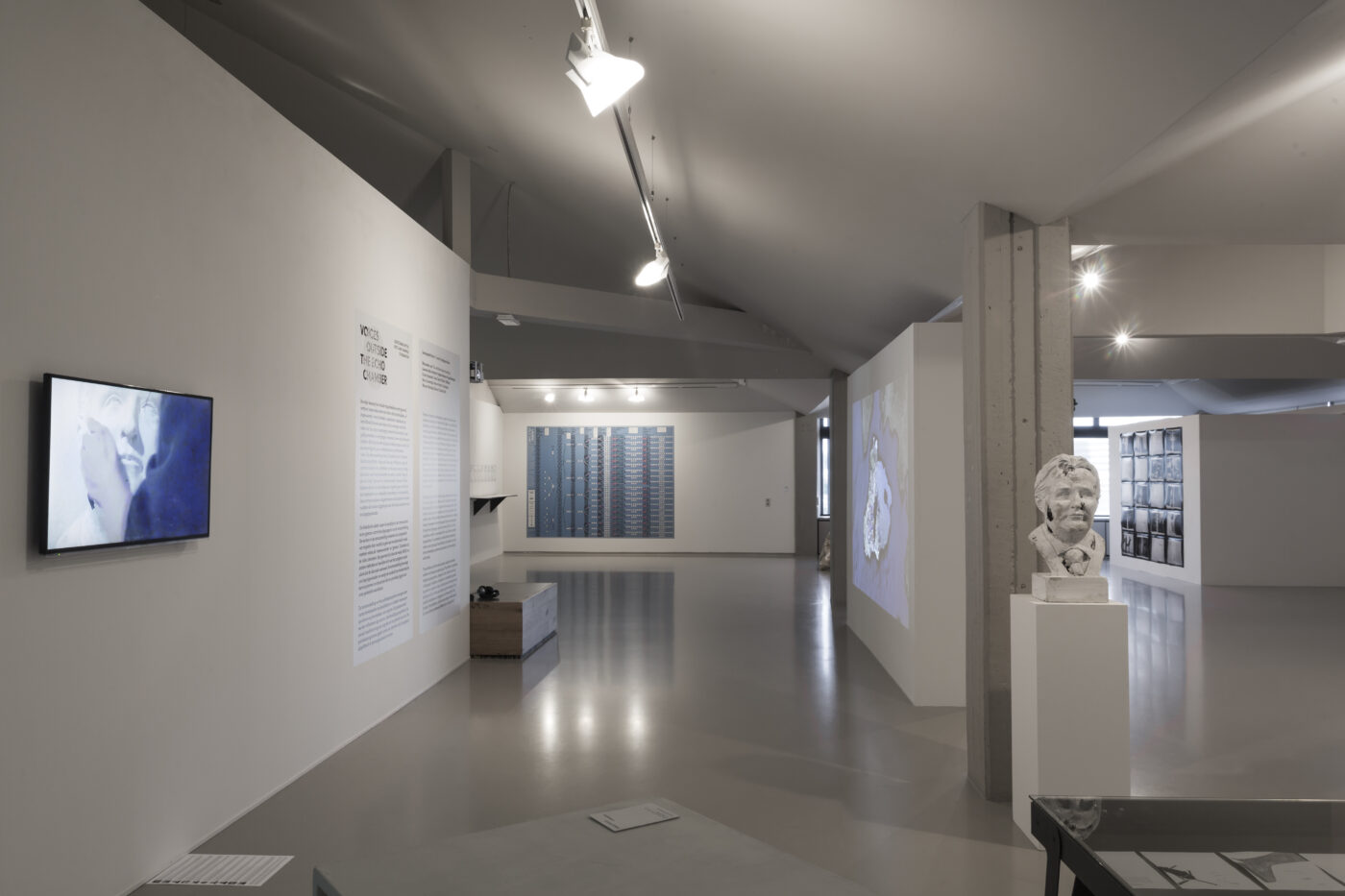Escaping the Echo Chamber: Perspectives on Immigrant Representations in the Exhibition Space
The discussion of migrations in the western European public sphere seems to have reached a peak since the beginning of the ‘refugee crisis’ in 2015. In response a growing number of artists and curators have been using their works to express concern regarding the current situation over the past years.1) Within this context, where a large amount of discourse is being produced, one could notice that representations, either political, journalistic or even artistic, have tended to focus primarily on the figure of the ‘refugee’, a term evoking, in the words of Bishupal Limbu, either “the image of a large mass of people linked […] to international humanitarian aid,” (Limbu 2009: 268) in order to advocate for humanitarian help, or in other cases as “an overwhelming influx of unwanted persons” (ibid.) to promote stricter border control. Either way, the constant repetition of these discourses creates a phenomenon of echo chambers, empty bubbles in which one is only confronted with information corroborating one’s own perspective, oversimplifying a much more complex phenomenon, namely migrations in their diverse contemporary forms.
The term refugee, originally an administrative term used to distinguish asylum seekers whose claims have been officially approved, and who as a result received access to a residence permit, has been increasingly used as an all-encompassing word to designate migrants trying to enter Europe. In contemporary political discourses ‘refugee’ is being used to name individuals leaving their countries because of persecution, regardless of administrative status, constituted in opposition to the so called ‘economic migrants,’ having to leave their countries because of economic pressure and poor living conditions.2) Consequently, the term refugee in part of the contemporary public discourses has arguably been used to create a dichotomy between people considered as good, ‘deserving’ migrants, and bad, or at least ‘undeserving’ ones.3) To avoid this pitfall this article prefers the term migrant, as a broader word to describe individuals having left a country to establish themselves in another, either temporarily or permanently.4) A large number of cultural institutions in Europe have been launching various programs and exhibitions to evoke the current situation of ‘refugees’ in Europe. While empathetic approaches highlighting the difficult living conditions of these migrants are often privileged, the exhibition Voices Outside the Echo Chamber: Questioning Myths, Facts and Framings of Migration, presented at the Framer Framed Gallery in Amsterdam from April 29th to June 3rd 2016, choose to focus on the notion of discourse itself. Curated by Katayoun Arian and articulated around a series of thirteen works, for the most part created before 2015, the exhibition attempted to deconstruct the representations made of migrant populations in Europe, and to challenge the idea of a ‘refugee crisis’ by focusing on the long-term and systemic issues at play within the European border control system. Considering the political implications of its discourse, Voices Outside the Echo Chamber also took part in a broader ongoing dialogue between art, politics and activism, interrogating the artist’s role in relation to society. Through the analysis of two artworks presented during the exhibition, Libia Castro and Ólafur Ólafsson’s audio sculpture Bosbolobosboco #6 (Departure-Transit-Arrival) and Lawrence Abu Hamdan’s Conflicted Phonemes this article will aim to discuss and question the narrativisation of migrants’ stories, focusing particularly on the mediation and reception of such narratives. As the two works present radically different perspective on the representation of migrations and migrant people, this article will propose a critical understanding of the different strategies they adopt, and how such strategies might impact social praxis.
EMPATHETIC REPRESENTATIONS
One of the strategies often used by contemporary artists to discuss migrations, and direct the public’s attention towards the idea of an urgent humanitarian crisis that needs solving, is to emphasize on the notion of empathy; in doing so artists often choose to rely on the evocation of individuals’ experiences. This is the case in Libia Castro and Ólafur Ólafsson’s 2014 audio sculpture Bosbolobosboco #6 (Departure-Transit-Arrival), the sixth work in a series of sculptures gathering audio montages concerned with various themes. This particular one focuses on experiences of migrations, as it invites visitors to take place in a biomorphic structure [fig. 1] and listen to an assemblage of migrants’ personal testimonies. The audio describing these departures and migrations, is supposed to be heard through a process of ‘deep listening’, according to the exhibition guide, encouraging visitors to relax and identify with the stories heard (Exhibition Guide Voices Outside the Echo Chamber 2016: 4). The work aims at producing empathy in the visitor, creating a link between the individuals sharing their stories and the listeners. It was produced in collaboration with the Sydney based collective The Refugee Art Project, its cofounder and artist Safdar Ahmed, and a psychologist, Nina Melksham, who can be heard guiding the reminiscences of the four contributors identified by their first names, Asif, Hadi, Mona and Shokufa, sharing memories of their journeys to Australia. As explained in the exhibition guide, the work aimed to resist voyeurism by having visitors relax and identify with the stories heard, in order to contribute to a form of “collective memory” (ibid.). In doing so, the artwork raises the issue of the narrativisation of migrants’ experiences and the use of identification as an artistic strategy, particularly considering how such approaches have been increasingly put at the forefront of contemporary socially engaged arts.
THE NARRATIVISATION OF MIGRATIONS
Considering that the exhibition Voices Outside the Echo Chamber dealt primarily with the notion of discourse and its impacts, one of the first questions coming to mind concerns the conditions of enunciation in the artworks: who’s voices shall be heard? How so? Who will listen to them? As the work Bosbolobosboco relies primarily on individuals’ stories of migration, its analysis will allow us to explore issues raised by the narrativisation of migrations, meaning the representation of migrations through the narration of individual migrants’ stories. In Bosbolobosboco whose voices shall be heard? The work is the product of collaboration between the artists, a psychologist, and the individuals sharing their stories, resulting in a several hours long audio montage. Migrant people are the ones telling their stories; however, the artists remain the intermediaries between the participating individuals and the listener. The presence of a psychologist whom we can hear asking questions and directing the exchange also contributes to shifting the narrative in certain directions. The work is committed to offering a safe space of expression to evoke traumatic experiences, and the psychologist uses relaxation methods and memory visualization, while regularly asking the participants if they wish to continue the interview when the memories recalled become overwhelming. As the audio exchange goes along the psychologist invites the interviewed to visualize and describe specific scenes, which they link to the notion of departure, transit or arrival. All the participants describe scenes concerning parting with loved ones; some also explain the anxiety felt when leaving one’s home and the difficulties of adjusting to new places. One of the participants also mentions his journey on a boat and its dangers, while another talks about being placed in a detention centre in Australia. These last two experiences are shared by the male participants while the female ones quite stereotypically focus on parting with their loved ones and seeing their dreams and envisioned futures shattered. One of them explains being only 6 at the time, while the other focuses on a particular memory at the airport. Overall the exchanges evoke specific moments which encapsulate feelings of displacement, and loss for the participants. The exhibition guide repeatedly uses the term trauma and explains that: “The sculpture is a testimony of the struggle of displacement, from before the departure to the arrival, and the journey’s lasting traumatic effects.” (ibid.)
Personal testimonies evoking trauma and resilience are commonly used in discourses about migrations by non-profits aiming at bettering migrants’ living conditions and by artists supporting this cause. Although there is no denying the legitimacy of these testimonies, it is striking to me that the vast majority of works I have been confronted with over the past 4–5 years had such a strong focus on refugees and narratives of trauma alone. In a western European context, where the name FRONTEX (the European border control agency) is very rarely mentioned in public discourses, and its actual practices even less, such a general over reliance on personal testimonies of suffering and resilience raises questions on the ability for such narratives to actually be transformative for society. As explained by Agnes Woolley in her 2016 article, to obtain a refugee status, asylum seekers must offer a convincing account of the persecutions they had to flee, and prove the sincerity of their claim. As the author explains: “the process relies heavily on the self-presentation of the individual claimant; their ability to convince an immigration officer or a judge. The claimant must narrate themselves into a position of legitimacy.” (Woolley 2016:5). Considering the reliance of the administrative process on asylum seekers’ ability to prove that they have been persecuted, it is striking that a large number of artworks, including Bosbolobosboco, focus their discussions on similar traumatic events lived by migrants. Even when evoking memories of a detention centre for instance, the emphasis is put on the individual’s emotions and lasting trauma, because the aim of the work is to work through this trauma rather than offer explanations on the border control system. In that sense, the work’s framing of migrants’ narratives paradoxically parallels the framing used during administrative processes.
Emphasizing the hardships and traumatic events migrants had to go through might, even unintentionally, support the idea that refugee status, and by extension acceptance in society, needs to be deserved. Although the idea of sympathizing with people’s stories seems a positive step taken by artists to change visitors’ perspectives on current debates about migrations, it might fail to critically deconstruct discourses, as the exhibition proposed to do, and even reinforce the particular narratives migrant people are cornered into due to the exclusionary logic of the border control system. Through its empathetic strategy Bosbolobosboco, like other artworks using similar methods, might paradoxically also participate to a broader frame in which migrants are only considered as legitimate speakers when recounting personal stories of hardship, making it difficult for individuals to be heard when producing a discourse which does not fit this particular framing. As migrants’ narratives remain limited to trauma and victimhood, legitimate social and political claims remain unaddressed and unrecognized.
Finally, although exhibitions spaces like Framer Framed, Amsterdam, aim at reaching the largest audience possible, the majority of its visitors are however more likely to share certain perspectives on the arts, as well as social and political topics. As such, one should be careful to avoid re-creating a form of discourse that neglects individual agencies, falling into an already existing consensual discourse, and in doing so reproducing its own ‘echo chamber’.
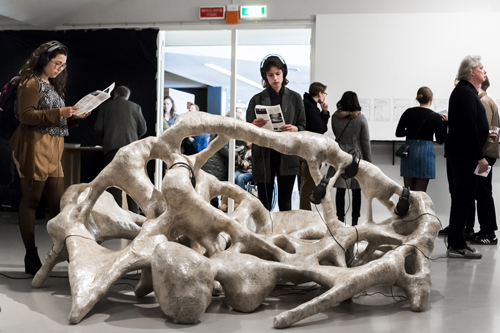
Libia Castro en Ólafur Ólafsson, Bosbolobosco #6. Foto: Marlise Steeman / Framer Framed
ETHICS OF EMPATHY AND IDENTIFICATION
Despite the issues raised by the narrativisation of migrant stories, the artwork Bosbolobosboco nonetheless confronts us with individuals offering first-hand accounts of their experiences. As such, totally dismissing the work because of its intrinsic limitations still poses a problem. The artwork presents us with first-hand audio testimonies, and although these can, and should be, analyzed critically, fully dismissing them would also be a form of silencing of migrant people. In fact, could the work still allow us, even ever so slightly, to shift perspectives on migrations and potentially transform social praxis?
According to the exhibition text, Bosbolobosboco invites visitors to “position themselves in the place of the observed” (Exhibition Guide: Echo Chamber 2016: 4). In Bosbolobosboco, the idea sustaining the work is that through listening to stories, one will be able to appropriate them as part of a larger, collective story, and visitors will be better able to sympathize with migrant people, which will perhaps change their views on migrations and the public policies that concern them. The idea of appropriating someone else’s traumatic memories, in order to enrich a larger collective memory, raises some issues. Indeed, such appropriation prompts viewers to abolish the differences between the self and the other, potentially casting aside elements of the other’s personhood in the process, to appropriate and consume experiences as, if not one’s own, at least communal ones.
One could also wonder about the possibilities for relaxation in a gallery space that visitors navigate and cross at all times. While listeners are invited to take place and lay inside the biomorphic sculpture, the stories that are heard are actually ones of displacement and hardship, they are highly emotional and listeners witness the difficulty participants have in recalling such memories. As such, relaxation seems like a fairly paradoxical goal to attain. However, the process of physically entering and laying in the sculpture, attempting, even forcing oneself, to relax while listening to the audio, forces the visitor to confront the testimonies, and to physically and emotionally commit to hearing them.
In their introduction to the Rhetoric of Sincerity Ernst van Alphen and Mieke Bal explain that: “traditionally sincerity [is understood] as natural enactment of authenticity, anchored in, and yielding truth, considered as fundamentally corporeal rather than textual” (van Alphen and Bal 2009:1). The corporeality of the concept of sincerity that van Alphen and Bal are alluding to is central to the ways migrant discourses are heard and analyzed. Throughout audition processes, and similarly in public and artistic discourses, individuals have to prove the authenticity of their claims by making convincing testimonies, and in doing so, by performing sincerity, through self-presentation, or even by showing bodily evidence such as scars (Woolley 2016:5). In a sense, Bosbolobosboco is able to shift this particular understanding of sincerity concerning testimonies of migrations, as the sculpture calls for the listener to become the one whose body is activated. In the work, the visitors’ physicality, and his/her reactions, are central, and the identification process, along with the emotions it might elicit are at the core of the work. More than bearing witness, the listener is asked to take in the stories he/she hears as shared ones, and to some extent participate in the work of sincerity by committing to relive one’s accounts as one’s own, engaging one’s body and emotions in doing so. By following the deep relaxation techniques that punctuate the testimonies, visitors are invited to appropriate the stories heard and paradoxically to take on an active posture by committing to them through these relaxation techniques. Although the work does not escape the issues posed by its reliance on narratives of trauma and its appropriative strategy, it might simultaneously allow for a shift in one’s understanding of migrant testimonies, through the active commitment it requires from its public.
CONFLICTED PHONEMES: ARTS AND ACTIVISM
Lawrence Abu Hamdan’s Conflicted Phonemes, displayed during the Voices Outside the Echo Chamber exhibition, is a vinyl wall print [fig. 2] from 2012, accompanied by nine charts printed on papers [fig. 3] visitors could take home. The work analyzed the littleknown language analysis tests introduced by the Dutch immigration authorities to determine the asylum seeker status of Somali immigrants before 2012. These tests analyzed the accents of asylum seekers in order to determine their regions of origin, and consequently decide if they could ‘legitimately’ obtain a refugee status. As northern regions of Somalia were considered as safer than other parts of the country, individuals determined to be originating from these sectors were consequently denied the asylum seeker status, unlike the people whose accents seemed to indicate that they came from the southern parts of the country. The tests were conducted by a private Swedish company, over a recorded phone interview from which a small number of words were extracted to then be analyzed (Abu Hamdan and Mircan 2012).
In response to these tests Abu Hamdan worked in collaboration with 12 Somali asylum seekers, as well as researchers, linguists, activists and a graphic designer, to create a graphic chart of the evolutions and transformations of the Somali language and its accents (Exhibition Guide: Echo Chamber 2016:2). The chart recalls the complexity of Somalia’s history, its different heritages, including that of the colonial period, and their impacts on the various accents and locutions present in the country. Doing so, it underlies the artificiality of the immigration authorities’ accent test. Furthermore, while the vast majority of Abu Hamdan’s works rely on explorations of sound, Conflicted Phonemes advocates for a right to silence by radically refusing to include speech, either in the form of migrant testimonies or voices in the work, which remains limited to visual charts and diagrams.5) Through its exploration of the complexity of language formation, understood as a dynamic process of exchanges, transformations and hybridity, the chart illustrates the arbitrariness of the language tests carried by the immigration office. Doing so, it also highlighted the little-known bureaucratic processes and methods used by migratory control systems, and made them available to the public. In that sense, Conflicted Phonemes offers a relevant take on the representation of migrations, as it opens up the discussion by putting the spotlight on particular border control policies which usually remain broadly unknown. As Abu Hamdan’s work opens up discourses on migration, it also raises the question of the impact of art on the political sphere.
SPEECH, SILENCE AND SINCERITY
With Conflicted Phonemes, the artist explores how forensic linguistics is used to determine identity, citizenship and places of origin. Through the practice of accent testing, one’s voice becomes a tool from which a legal truth is derived. While such practice focuses on the corporeal aspect of
speech, content is considered superficial. In that sense, the work represents a fairly literal application of the notion of sincerity as explained earlier. Indeed, the claimant’s body becomes scrutinized for traces of an inner truth, an accent which would link back to one’s place of origin. In that sense the body’s manifestations are seen as objective, and objectifiable, clues, spontaneously performing sincerity. The content of asylum seekers’ speech is cast aside, and individuals are forced to perform a specific narrative, telling traumatic stories using intonations, postures, accents etc. that will convince the immigration authorities, whose decision can make the difference between life and death. Furthermore, the work illustrates the inherent issues lying in accent testing, showing how it ignores the dynamism of language, instead, wrongly considering one’s way of speaking as statically reflecting one’s supposedly fixed ‘origin.’ As the charts demonstrate the impacts of colonisation on the evolutions of the Somali languages, it is striking to notice the complete lack of acknowledgement of colonial history in both accent testing and the broader understanding of migrations.
By shedding light on the assumptions the legal process of asylum seeking relies on, Conflicted Phonemes interrogates what is actually listened to when ‘listening to the voices of migrants.’ Beyond its critique of the border control processes, the work also interrogates the very idea of listening to migrants, and its collateral ‘giving them a voice’, especially present in humanistic discourses.6) Either by insisting on narratives of trauma, or upon corporeal aspects of speech, migrant voices become co-opted to fit particular representations. This includes a number of projects and organisations which showcase migrants’ testimonies, which while ‘giving a voice’ to individuals, nonetheless select and frame such testimonies so that they often follow a similar structure in their storytelling.7) As Leonie Harsch notes in her 2018 article on the 2011 UN Refugee Agency communication campaign, the emphasis can be put on stories of hardship and resilience, in the hope that viewers will engage better with the testimonies, and perhaps change their views or even donate to the organization. By refusing to showcase voices or testimonies to evoke migrations, Abu Hamdan questions what we as a public are expecting, or are willing, to hear and reflect upon when listening to migrants’ voices.
ART, ACTIVISM AND DEMOCRACY
The choice made by Abu Hamdan to share information on particular border control policies with the public, while radically excluding voices or personal testimonies from his work, seems particularly effective in criticising the narrativisation of migrant experiences. Considering how obscure border control systems tend to be for the public at large, informing European and especially Dutch citizens visiting the exhibition space on the particular policies their states enact is a relevant method to open up debates on the topic of migrations and transform the ways migrations are perceived and talked about. While all works evoking migrations bring topics to the attention of the public, focusing on actual policies allows individuals to discuss concrete political issues. Doing so makes viewers aware of their citizen status, and encourages them to pay attention to the concrete legal and political stances taken in their countries. Rather than focusing on broader ideas and concepts, which at
times might make individuals feel overwhelmed and unable to act, the work targets specific policies which can be changed or repealed. Although information does not necessarily mean taking action, knowing about practical laws and procedures can however open up discussions in society on concrete issues upon which citizenship has a direct impact. Nevertheless one can note the irony of having to efface migrant voices to actually talk about the concrete issues they encounter when facing border control systems.
Interestingly the work had an even more direct impact when it was presented before a chief judge working with the Dutch immigration authority, as well as at a deportation hearing at the United Kingdom Asylum tribunal (Exhibition Guide: Echo Chamber 2016: 2). Despite these and other hearings and appeals, accent testing carried over either by public or private institutions is still broadly used by various countries to this day, including but not limited to Germany, the United Kingdom, the Netherlands, Denmark, Switzerland and Australia.8) The fact that the work Conflicted Phonemes, or perhaps more accurately the information it gathered and presented, was shown during official court hearings further illustrates the possibilities of focusing on particular policies. The work helped put the spotlight on the issues raised by accent testing, notably by showing the richness of languages and accents present in Somalia. Although the court ruled against these particular tests, the fact that slightly different versions of these soon replaced them highlights the limits encountered when presented considering the work within a different context, that of the trial. While Conflicted Phonemes might be able to impact viewers and citizens, the relative failure of the court hearing to take notice and make changes shows the difficulty of confronting the current regime.
ETHICS OF REPRESENTATION
The exhibition Voices Outside the Echo Chamber: Questioning Myths, Facts and Framings of Migration presented its visitors with various engaging viewpoints on the ways migrations and migrant people are represented in contemporary discourses, urging viewers to question and rethink such representations. Abu Hamdan’s work Conflicted Phonemes does so precisely by interrogating the actual conditions of listening to migrants’ speech. In that sense, the work simultaneously invites visitors of the exhibition to interrogate their own reception of the artworks on display. Comparing Conflicted Phonemes to Castro and Olafsson’s Bosbolobosboco, one is inspired to question the ways one listens to and understands the audio sculpture and the testimonies presented. These testimonies, recounting personal stories of hardship and trauma, mirror the administrative
narrative asylum seekers must follow in order to be perceived as legitimate. Claimants must prove that they are threatened in their countries of origin by recounting personal experiences to the immigration authorities while in the work individuals repeat their stories, adding the hardships they had to face during the administrative processes to underline the issues the later pose. While the narrativisation of migrants’ experiences raises the problem of the limitations it puts on migrants’ expressions, comparing the works Bosbolobosboco and Conflicted Phonemes allows us to further question what is being listened to when one is said to ‘listen to the voices of migrants’. In that sense, the works viewed together bring the visitor to acknowledge the interpretative part of their reception of migrant’s discourses, be it by questioning the act of listening to voices in Conflicted Phonemes, or by asking for a radical commitment to the stories from the listener in the work Bosbolobosboco.
Claire E. Jandot
Zeitschrift für Geschlechterforschung und visuelle Kultur, Issue 66 (2019)
NOTES
1) A famous example is Ai Weiwei’s film Human Flow (2017), similarly many various cultural institutions have been organizing exhibitions on the theme of migrations or exhibiting artists working on this theme such as The Humanity House in The Hague. 2) As an example see the definition of ‘economic migrant’ on the European Commission’s website, which mentions the two terms to establish the difference between them: https://ec.europa.eu/home-affairs/content/economic-migrant_en. 3) For further discussion on terminologies and their significances, see Carastathis, Kouri-Towe, Mahrouse and Whitley (2018: 3–4).
4) Although the category of people considered as ‘expats’ falls under this broad definition they will not be considered in this article because they are in discourses and in practices considered distinct by their racial and class privileges. In the Netherlands for instance they constitute a different administrative category determined by income or profession.
5) In the artwork Contra Diction: Speech Against Itself from 2016 Abu Hamdan further explores and explains how he understands the right to silence and its implications.
6) The discussion of this concept is also central within feminist scholarship; see for instance Mohanty (1984) and Spivak (1988).
7) As an example see Leonie Harsch’s 2018 analysis of the UN Refugee Agency communication campaign https://refugeehosts.org/2018/01/08/giving-refugees-a-voice-looking-beyondrefugee-stories/
8) Academic articles concerning this topic are somewhat scarce; however Reath (2004) presents the general functioning of accent testing. If the reader is further interested, see also Mohdin (2015).
// REFERENCES
Abu Hamdan, Lawrence / Mircan, Mihnea (2012): Conflicted Phonemes. http://www.neromagazine.it/magazine/index.phpc=articolo&idart=1078&idnum=42&num=32 (March 5, 2019)
Carastathis, Anna / Kouri-Towe, Natalie / Mahrouse, Gada / Whitley, Leila (2018): Introduction. In: Refuge. Vol. 34, Issue 1, pp. 3–15 Exhibition Guide. Voices Outside the Echo Chamber. Framer Framed, Amsterdam, 2016
Harsch, Leonie (2018): Giving Refugees a Voice? Looking Beyond ‘Refugee Stories’. https://refugeehosts.org/2018/01/08/giving-refugees-a-voice-looking-beyond-refugee-stories/ (April 2019)
Limbu, Bishupal (2009): Illegible Humanity: The Refugee, Human Rights, and the Question of Representation. In: Journal of Refugee Studies. Vol. 22, Issue 3, pp. 257–282
Mohanty, Chandra Talpade (1984): Under Western Eyes: Feminist Scholarship and Colonial Discourses. In: boundary. Vol. 12, Issue 3, pp. 333–358
Mohdin, Aamna (2015): After braving death to reach Europe, this is the final test refugees must pass to win asylum. https://qz.com/508785/these-companies-use-language-to-determine-whichmigrants-get-to-stay-in-europe-but-does-it-work/ (March 5, 2019)
Reath, Anne (2004): Language Analysis in the Context of the Asylum Process: Procedures, Validity, and Consequences. In: Language Assessment Quarterly: An International Journal. Vol. 1, Issue 4, pp. 209–233
Spivak, Gayatri (1988): Can the Subaltern Speak? In Nelson, Cary / Grossberg, Lawrence (eds.), Marxism and the Interpretation of Culture. Urbana, University of Illinois Press, pp. 271–313
UNHCR Master Glossary of Terms: economic migrant. https://ec.europa.eu/home-affairs/content/
economic-migrant_en (March 5, 2019)
Van Alphen, Ernst / Bal, Mieke (2009): Introduction. In: Van Alphen, Ernst / Bal, Mieke / Smith, Carel(eds.), The Rhetoric of Sincerity. Stanford CA, Stanford University Press, pp. 1–16
Woolley, Agnes (2016): Narrating the ‘Asylum Story’: Between Literary and Legal Storytelling. In: Interventions: International Journal of Postcolonial Studies. Vol. 19, Issue 3, pp.1–19
// ABOUT THE AUTHOR
Claire Elisabeth Jandot has a Masters degree in Arts and Culture, for which she wrote a thesis on the display of historical African sculptures in French museums, with a particular focus on the Quai Branly, and the ways the institution negotiates the colonial history of its collections. She is currently finishing a research Master at Leiden University, working on representations of immigration in the context of the Museum of Immigration History, located in Paris, in the former Colonial Museum built in 1931.
// FKW is supported by the Mariann Steegmann Institute and the Institute for Cultural Studies in the Arts Zurich University of the Arts Sigrid Adorf / Kerstin Brandes / Edith Futscher / Kathrin Heinz / Anja Herrmann / Marietta Kesting / Marianne Koos / Mona Schieren / Kea Wienand / Anja Zimmermann / www.fkw-journal.de
// LICENSE
This work is licensed under the CC-BY-ND License 4.0. To view a copy of this license, visit:
https://creativecommons.org/licenses/by-nc-nd/4.0/legalcode
Migration / Art and Activism /
Exhibitions
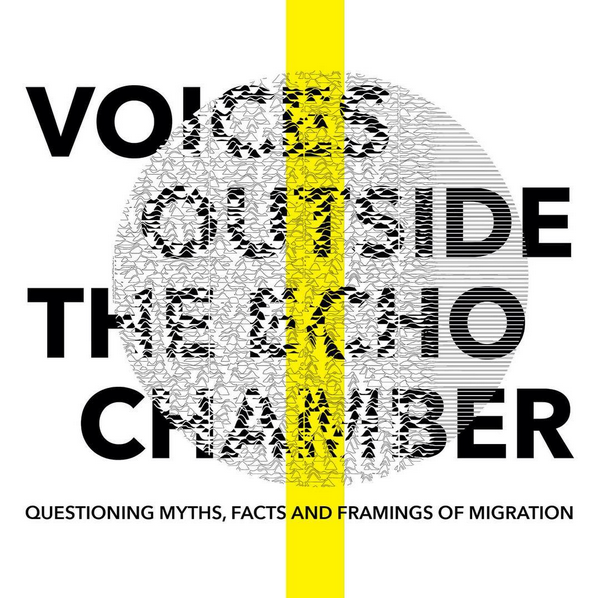
Exhibition: Voices Outside the Echo Chamber
Questioning Myths, Facts and Framings of Migration, curated by Katayoun Arian
Network

Lawrence Abu Hamdan
Artist


